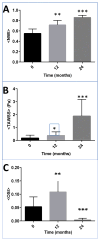Patient-Specific Flow Descriptors and Normalized wall index in Peripheral Artery Disease: a Preliminary Study
- PMID: 29503774
- PMCID: PMC5830147
- DOI: 10.1080/21681163.2016.1184589
Patient-Specific Flow Descriptors and Normalized wall index in Peripheral Artery Disease: a Preliminary Study
Abstract
Background and aims: MRI-based hemodynamics have been applied to study the relationship between time-averaged wall shear stresses (TAWSS), oscillatory shear index (OSI) and atherosclerotic lesions in the coronary arteries, carotid artery, and human aorta. However, the role of TAWSS and OSI are poorly understood in lower extremity arteries. The aim of this work was to investigate the feasibility of hemodynamic assessment of the superficial femoral artery (SFA) in patients with peripheral artery disease (PAD) and we hypothesized that there is an association between TAWSS and OSI, respectively, and atherosclerotic burden expressed as the normalized wall index (NWI).
Methods: Six cases of 3D vascular geometries of the SFA and related inlet/outlet flow conditions were extracted from patient-specific MRI data including baseline, 12 and 24 months. Blood flow simulations were performed to compute flow descriptors, including TAWSS and OSI, and NWI.
Results: NWI was correlated positively with TAWSS (correlation coefficient: r = 0.592; p < 0.05). NWI was correlated negatively with OSI (correlation coefficient: r = -0.310, p < 0.01). Spatially averaged TAWSS and average NWI increased significantly between baseline and 24-months, whereas OSI decreased over 2-years.
Conclusions: In this pilot study with a limited sample size, TAWSS was positively associated with NWI, a measure of plaque burden, whereas OSI showed an inverse relationship. However, our findings need to be verified in a larger prospective study. MRI-based study of hemodynamics is feasible in the superficial femoral artery.
Conflict of interest statement
Conflict of interest: None (JS), None (GB), None (JM), None (CB), None (AL), None (DS), None (PD).
Figures







Similar articles
-
Anatomical location-related hemodynamic variations are associated with atherosclerosis in the middle cerebral artery: a preliminary cross-sectional 4D flow and 3D vessel wall MRI study.Quant Imaging Med Surg. 2025 Apr 1;15(4):3585-3601. doi: 10.21037/qims-24-1733. Epub 2025 Mar 13. Quant Imaging Med Surg. 2025. PMID: 40235780 Free PMC article.
-
Assessment of Complex Flow Patterns in Patients With Carotid Webs, Patients With Carotid Atherosclerosis, and Healthy Subjects Using 4D Flow MRI.J Magn Reson Imaging. 2024 Jun;59(6):2001-2010. doi: 10.1002/jmri.29013. Epub 2023 Sep 14. J Magn Reson Imaging. 2024. PMID: 37706274 Free PMC article.
-
The Correlation Between Wall Shear Stress and Plaque Composition in Advanced Human Carotid Atherosclerosis.Front Bioeng Biotechnol. 2022 Jan 28;9:828577. doi: 10.3389/fbioe.2021.828577. eCollection 2021. Front Bioeng Biotechnol. 2022. PMID: 35155418 Free PMC article.
-
Slice-based and time-specific hemodynamic measurements discriminate carotid artery vulnerable atherosclerotic plaques.Comput Methods Programs Biomed. 2022 Oct;225:107050. doi: 10.1016/j.cmpb.2022.107050. Epub 2022 Aug 3. Comput Methods Programs Biomed. 2022. PMID: 35985150
-
How does hemodynamics affect rupture tissue mechanics in abdominal aortic aneurysm: Focus on wall shear stress derived parameters, time-averaged wall shear stress, oscillatory shear index, endothelial cell activation potential, and relative residence time.Comput Biol Med. 2023 Mar;154:106609. doi: 10.1016/j.compbiomed.2023.106609. Epub 2023 Jan 23. Comput Biol Med. 2023. PMID: 36724610 Review.
Cited by
-
Longitudinal Magnetic Resonance Imaging-Based Superficial Femoral Artery Velocity Measurements in Diabetic and Nondiabetic Patients With Peripheral Artery Disease.Top Magn Reson Imaging. 2023 Dec 1;32(6):57-65. doi: 10.1097/RMR.0000000000000309. Epub 2023 Nov 17. Top Magn Reson Imaging. 2023. PMID: 38051028 Free PMC article. Clinical Trial.
-
Experimental and Mouse-Specific Computational Models of the Fbln4SMKO Mouse to Identify Potential Biomarkers for Ascending Thoracic Aortic Aneurysm.Cardiovasc Eng Technol. 2022 Aug;13(4):558-572. doi: 10.1007/s13239-021-00600-4. Epub 2022 Jan 22. Cardiovasc Eng Technol. 2022. PMID: 35064559 Free PMC article.
-
Magnetic resonance imaging based modeling of microvascular perfusion in patients with peripheral artery disease.J Biomech. 2019 Aug 27;93:147-158. doi: 10.1016/j.jbiomech.2019.06.025. Epub 2019 Jul 8. J Biomech. 2019. PMID: 31331663 Free PMC article.
-
Magnetic Resonance Imaging-Derived Microvascular Perfusion Modeling to Assess Peripheral Artery Disease.J Am Heart Assoc. 2023 Feb 7;12(3):e027649. doi: 10.1161/JAHA.122.027649. Epub 2023 Jan 23. J Am Heart Assoc. 2023. PMID: 36688362 Free PMC article.
-
Emerging Role of Carotid MRI for Personalized Ischemic Stroke Risk Prediction in Patients With Carotid Artery Stenosis.Front Neurol. 2021 Aug 3;12:718438. doi: 10.3389/fneur.2021.718438. eCollection 2021. Front Neurol. 2021. PMID: 34413828 Free PMC article. Review.
References
Grants and funding
LinkOut - more resources
Full Text Sources
Other Literature Sources
